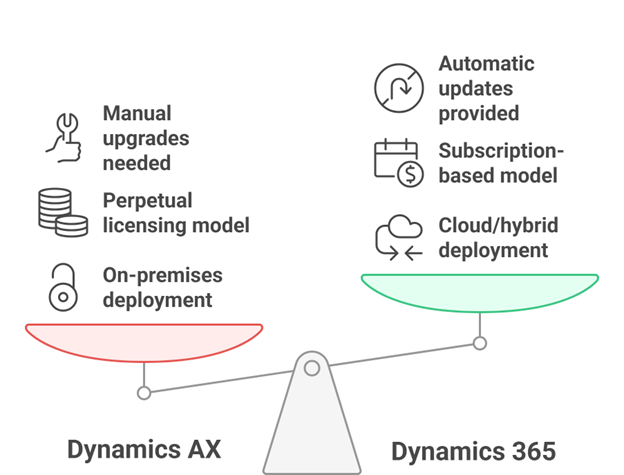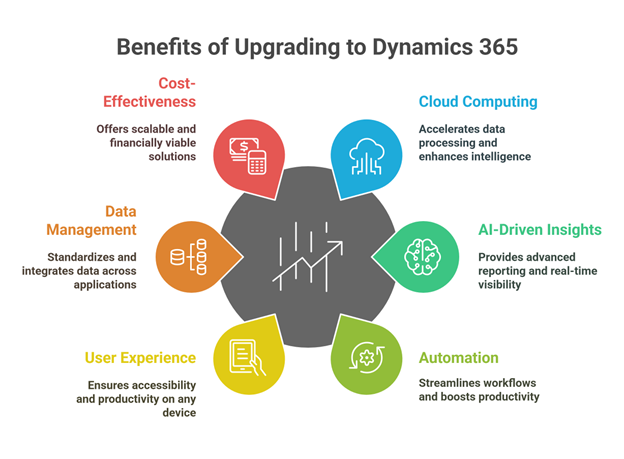Dynamics 365 vs. Dynamics AX: The Future of ERP and Why You Should Upgrade
For years, Dynamics AX served as a powerful on-premises enterprise resource planning (ERP) solution for large enterprises. It provided businesses with the tools needed to manage finances, supply chains, and operations effectively. However, Microsoft has since rebranded and evolved this system into Dynamics 365 Finance & Supply Chain Management, a cloud-based solution that integrates ERP and CRM applications.
This shift is more than just a name change. Dynamics 365 introduces a modular structure, allowing businesses to tailor the platform to their needs. Unlike Dynamics AX, which required manual updates and infrastructure maintenance, Dynamics 365 offers continuous improvements and cloud-based flexibility.
Microsoft has ended mainstream support for Dynamics AX, leaving legacy users exposed to potential security vulnerabilities and system inefficiencies. Without updates or patches, businesses relying on AX face increased operational risks. Migrating to Dynamics 365 ensures access to the latest technology, enhanced security, and ongoing innovation, making it the logical step forward for companies looking to stay competitive.
What Do Dynamics AX and Dynamics 365 Have in Common?
Despite the transition from Dynamics AX to Dynamics 365, some core strengths remain unchanged. Both platforms provide powerful business intelligence tools, enabling organizations to analyze data effectively and make informed decisions. Advanced analytics and reporting capabilities are built into both solutions, helping businesses track performance and uncover insights.
User experience is another area where Dynamics AX and Dynamics 365 align. Both offer an intuitive interface designed to simplify navigation and streamline daily operations. Whether generating reports, managing workflows, or accessing key metrics, users familiar with AX will find a similar ease of use in Dynamics 365. While the technology has evolved, these essential features continue to support business efficiency.
Key Differences Between Dynamics AX and Dynamics 365
Dynamics AX and Dynamics 365 share the same foundation, but the shift to the cloud has introduced major differences in how businesses manage their ERP systems. From deployment flexibility to security enhancements, Dynamics 365 offers a more modern, integrated, and scalable approach. Here’s how the two compare:
- Deployment Options: Dynamics AX was strictly on-premises, requiring dedicated infrastructure. Dynamics 365 offers both cloud and hybrid deployment models, providing greater flexibility.
- Licensing Model: AX used a one-time perpetual licensing model. Dynamics 365 operates on a subscription basis, making costs more predictable and scalable.
- Updates and Maintenance: Dynamics AX required manual upgrades, often leading to downtime and high IT costs. Dynamics 365 delivers automatic updates, ensuring businesses always have access to the latest features and security patches.
- Integration Capabilities: AX had limited integration with external systems. Dynamics 365 seamlessly connects with Microsoft 365, Power Platform, and other third-party applications, streamlining business processes.
- Security and Access Control: Dynamics 365 introduces advanced security features, including role-based access and new compliance tools, offering better protection against cyber threats.
- Business Intelligence: While AX included reporting features, Dynamics 365 takes analytics further with Power BI and AI-driven insights, improving decision-making.
- Scalability: AX was primarily built for large enterprises. Dynamics 365 is designed to accommodate businesses of all sizes, allowing smaller organizations to leverage enterprise-grade ERP capabilities.

Challenges of Staying on Dynamics AX
Continuing to run Dynamics AX comes with significant drawbacks. Microsoft has officially ended support for Dynamics AX, meaning no more updates, patches, or security fixes. Running an unsupported system exposes businesses to security risks, compliance issues, and increasing maintenance costs. Moving to Dynamics 365 ensures continuous support, access to the latest features, and a future-proof ERP solution designed to evolve with business needs.
Here’s why staying on Dynamics AX can be a costly decision:
- No Security or Feature Updates: With Microsoft ending support, Dynamics AX no longer receives security patches, bug fixes, or new features, leaving systems exposed to threats.
- Rising Maintenance Costs: Running an outdated ERP means relying on aging infrastructure and limited vendor support, which leads to higher operational expenses.
- Compliance Risks: Regulatory standards continue to evolve, and outdated software may not meet industry-specific compliance requirements, creating legal and financial risks.
- Limited Scalability: Expanding business operations becomes challenging with an ERP that lacks the flexibility and performance needed to support growth.
- Lack of Cloud Integration: Dynamics AX was not designed for modern cloud environments, making it difficult to integrate seamlessly with Microsoft’s latest cloud services.
- Performance and Efficiency Concerns: As businesses grow, outdated architecture can lead to slow performance, system inefficiencies, and operational bottlenecks.
Key Benefits of Upgrading to Dynamics 365
Migrating to Dynamics 365 is more than just adopting the latest Microsoft technology. It’s about transforming business operations with cloud-based capabilities, AI-driven insights, and enhanced automation. Dynamics 365 streamlines workflows, improves decision-making, and reduces costs. Here’s what sets it apart:
- Smarter Decision-Making: Cloud computing accelerates data processing and enhances intelligence, helping businesses make faster, more informed decisions.
- Improved Efficiency: Personal workspaces and task prioritization features enable employees to work smarter and boost overall productivity.
- Seamless User Experience: The modern, intuitive interface ensures accessibility, allowing users to stay productive on any device.

- Deeper Business Insights: AI-powered analytics, Power BI, and Cortana Intelligence deliver advanced reporting with real-time visibility into business performance.
- Simplified Data Management: The Common Data Model (CDM) standardizes and integrates data across applications, eliminating silos and improving consistency.
- Frequent Updates: Cloud deployment ensures businesses receive automatic updates, keeping them equipped with the latest features and security enhancements.
- Cost-Effective and Flexible: The subscription-based pricing model lowers upfront costs, making it a scalable and financially viable solution for businesses of all sizes.
Make the Move to Dynamics 365 with Apps4Rent
Sticking with Dynamics AX is no longer a practical option. Without Microsoft’s support, businesses face increasing risks, including security vulnerabilities and outdated functionality. Upgrading to Dynamics 365 is not just about keeping pace with technology but about adopting a future-ready solution that drives efficiency and growth.
Dynamics 365 provides continuous innovation, stronger security, and seamless cloud integration. Businesses benefit from greater flexibility, improved efficiency, and access to advanced tools that streamline operations. With automatic updates and scalable deployment options, organizations can stay competitive without the burden of manual upgrades.
As a Microsoft Solutions Partner, Apps4Rent offers a variety of Dynamics 365 plans designed to meet different business needs. We also provide comprehensive Microsoft 365 services, ensuring a smooth transition with expert support at every step. Whether you need to migrate mail services or enhance your cloud strategy, our team is ready to assist. Contact us today to find the right Dynamics 365 solution for your business.


